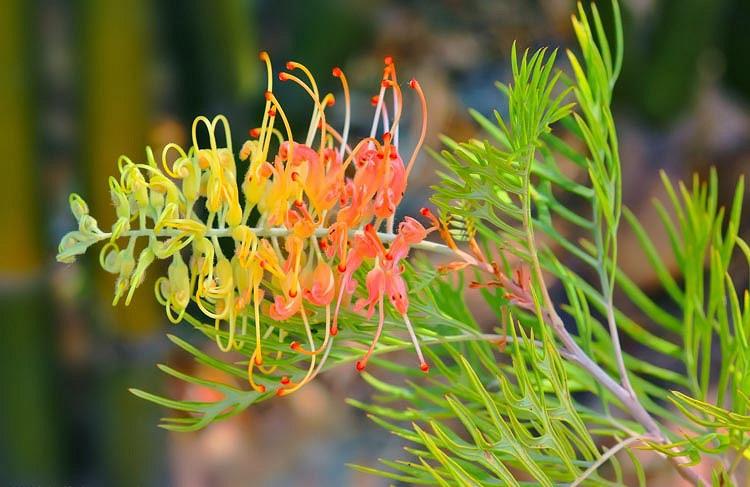Problems With Grevillea Plants
Pest Disease Problems Grevilleas are generally trouble free plants provided they are growing in free-draining soil and receive enough sunlight. Grevillea robusta commonly known as the southern silky oak silk oak or silky oak silver oak or Australian silver oak is a flowering plant in the family Proteaceae.

Grevillea Peaches And Cream Source: www.gardenia.net
Most are drought tolerant once established.

Problems with grevillea plants. The grevillea robusta is a fast growing tree which allows it to achieve its huge size. Add these two factors plus the fact that it is a messy tree that loses branches leaves and flowers means that you want to keep other plants away from it. Hakea species all have thick woody follicles fruits that persist on the plant for some time protecting the seeds until a fire pops them open while almost all species of Grevillea have thin-valved leathery follicles that open without fire and are then shed after the seeds fall.
Although the tree is tall the wood is very brittle and the top branches are known to blow off in heavy winds. However poor drainage or overwatering can lead to root rot. Common Problems With Grevilleas Though the Grevillea species is generally hardy any plants can experience issues from time to time.
Grevillea is relatively problem-free. A grevilleas natural response to the one-in-300-year droughts that our climate is prone to is to flower set seed and die with its offspring germinating when the wet stuff falls from the sky again with occasionally a bushfire to spark things along. I have mulched it and put on bark chippings we had alot of deep rain unusually at the beginning of June and since then no rain.
Many grevilleas will set seed and grow quite readily. It is a tree the largest species in its genus but is not closely related to the true oaks QuercusIt is a native of eastern coastal Australia growing in riverine subtropical and dry rainforest environments. As with all members of the Proteaceae family Grevilleas should not be fed with fertilizer containing phosphorus.
These can be avoided by planting in appropriate soil or potting mix. Grevillea require a sunny position with light gritty free-draining soil that is low in phosphates. These plants dislike having wet feet.
A combination of loam peat moss and sand ensures drainage yet some moisture retention. Grevillea plants can withstand periods of drought but perform best when kept moderately damp. But its watered daily on a drip and by hose.
Grevillea make fine hedges or screens or background plants. The main issues that may be encountered are various root rots and other soil problems that are related to poor drainage. This evergreen has a rugged look.
If your grevillea does come under threat from any of the common pests the plants natural resistance will usually be enough to overcome the problem. Some spots may leave holes in the leaves when they drop out. Since Grevilleas are such a broad type of plant and tree the exact issues that are encountered will depend on the exact species and cultivar.
This is not attractive behaviour in the garden. If the drainage is poor then grevilleas can quickly suffer from root rot diseases like phytophthora. Grevillea trees and shrubs are evergreen deer-resistant and fuss-free choices for privacy screen specimen plants and ground covers depending on the species and will be happy in warm temperate gardens that remind them of their native Australian climate.
Can be easily propagated from cuttings. Symptoms of phyllosticta include premature yellowing of leaves and the appearance of round or irregular gray brown or black spots. Ensure that the soil is well drained and that they are not sitting in a moist soil for long periods.
Grevillea is very fast growing and can live 50 to 65 years. It can grow to be over 100 feet 30 m tall but most mature trees are around 50 to 80 feet 15-24 m high and 25 feet 8 m wide. Fungal pathogen Phytophthora cinnamomi attacks the conducting tissues of the plant causing it to wilt and finally collapse.
Some people are allergic to prickly grevillea leaves so be aware of this as a potential problem in the garden. Propagation is from half-hardened cuttings. Growing grevilleas from seeds.
More importantly it can also be invasive. Type Evergreen shrubs trees. I dont know what I am doing wrong.
Caring for Grevillea plants indoors entails a good planting mix at the beginning. A few cultivars are grafted and. Grevillea are very hardy and are not susceptible to many diseases or pests.
I planted a Grevillea olivacea in aprillate spring hereand its curling up its toes. Grevilleas can become infected with cercospora and phyllostica two fungal diseases that favor humid conditions. Sooty mould can be controlled with eco-oil.

Pin On Planting Scheme For Sarah Source: www.pinterest.com

Pin On Garden Flowers Source: www.pinterest.com

Pin On Cut Flowers Source: www.pinterest.com

Pin On Shrubs Source: www.pinterest.com

Grevillea Species Silk Oak Silky Oak Silver Oak Grevillea Robusta Source: davesgarden.com

